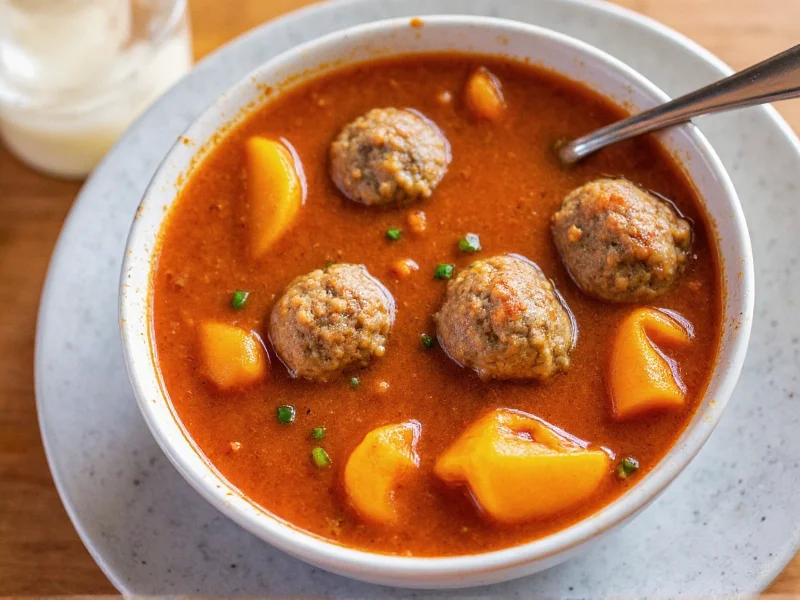The Essential Framework for Perfect Meatball Soup
Creating exceptional meatball soup requires understanding three critical components: the meatballs, the broth, and the supporting elements. Unlike many online recipes that treat this dish as an afterthought, professional kitchen techniques reveal how small adjustments dramatically improve results.
Why Most Meatball Soup Recipes Fail
Common pitfalls include dense meatballs (from overmixing), bland broth (using water instead of quality stock), and soggy pasta (added too early). The difference between adequate and outstanding meatball soup lies in technique, not complexity. As culinary professionals know, the secret is balancing moisture in meatballs while building layered flavors in the broth.
Classic Italian Wedding Soup Recipe
This authentic preparation—known as minestra maritata in Naples—features delicate meatballs in a clear, aromatic broth with leafy greens. Despite its name, it's not served at weddings but refers to the "married" flavors of meat and greens.
Ingredients for 6 Servings
- 1 lb ground beef (80% lean)
- ½ lb ground pork
- 2 oz day-old Italian bread, crust removed
- ¼ cup whole milk
- 1 large egg
- 3 tbsp grated Parmesan
- 2 cloves garlic, minced
- 4 cups homemade chicken stock
- 1 Parmesan rind
- 2 oz escarole or spinach, chopped
- 2 oz small pasta (acini di pepe or orzo)
- Fresh parsley, for garnish
Step-by-Step Preparation
- Soak bread in milk for 10 minutes until saturated
- Mix meat, soaked bread, egg, Parmesan, and garlic gently with hands
- Form ¾-inch meatballs (size of large marbles)
- Bring stock and Parmesan rind to gentle simmer
- Add meatballs; cook 8 minutes without stirring
- Add pasta; simmer 5 minutes
- Stir in greens; cook 2 minutes until wilted
- Season with salt, pepper, and lemon juice to taste
Pro Techniques for Restaurant-Quality Results
Professional chefs employ these often-overlooked methods:
- Meatball texture secret: Chill mixture for 30 minutes before shaping for tender results
- Broth enhancement: Simmer with Parmesan rind and a bay leaf for 20 minutes before adding meatballs
- Prevent mushy pasta: Cook pasta separately and add to individual bowls when serving
- Flavor balance: Finish with lemon juice to brighten rich broth
Popular Meatball Soup Variations
Different cultures have adapted this comforting dish. The table below shows key differences:
| Variation | Key Ingredients | Preparation Difference | Dietary Adaptation |
|---|---|---|---|
| Swedish Meatball Soup | Beef-pork blend, allspice, cream | Thickened with roux, served with lingonberry | Gluten-free with cornstarch |
| Chicken Meatball Version | Ground chicken, lemon zest, dill | Lighter broth, quicker cooking time | Lower fat, paleo-friendly |
| Vegetarian Adaptation | Mushroom-walnut "meatballs", miso | Umami from mushrooms replaces meat | Vegan with nutritional yeast |
Troubleshooting Common Issues
Even experienced cooks encounter these challenges:
Fixing Bland Broth
If your broth lacks depth, add one of these elements:
- Simmer with extra Parmesan rind for 15 minutes
- Add 1 tsp tomato paste cooked in olive oil
- Stir in ½ tsp fish sauce (undetectable but boosts umami)
Preventing Tough Meatballs
Mix ingredients gently with fingertips—never use tools. Overmixing develops gluten in breadcrumbs, creating dense meatballs. Keep mixture cold and handle minimally.
Storage and Reheating Guide
Meatball soup maintains quality for 3-4 days refrigerated. For best results:
- Store components separately: broth, meatballs, pasta
- Reheat broth first, then add other elements
- Freeze meatballs flat on baking sheet before transferring to bags
Seasonal Adaptations for Year-Round Enjoyment
Adjust ingredients based on fresh availability:
- Spring: Add fresh peas and mint to meatball mixture
- Summer: Use garden tomatoes and basil in broth
- Fall: Incorporate roasted squash and sage
- Winter: Add hearty greens like kale and escarole
Frequently Asked Questions
Can I make meatball soup gluten-free?
Yes, use gluten-free breadcrumbs made from rice or corn in the meatballs, and substitute quinoa or gluten-free pasta. For thickening, use cornstarch instead of flour. Many traditional Italian versions actually omit pasta entirely, focusing on the meatball and broth elements.
How do I prevent meatballs from falling apart in soup?
The key is proper binder ratio—use 1 part bread to 4 parts meat by weight. Soak the bread thoroughly in milk first. Chill the mixture before shaping, and don't stir the soup during the first 5 minutes of cooking. Gently nudge meatballs with a spoon rather than stirring vigorously.
What's the difference between Italian wedding soup and regular meatball soup?
Italian wedding soup (minestra maritata) specifically features small meatballs in a clear broth with leafy greens like escarole, plus small pasta. Regular meatball soup often has larger meatballs in tomato-based broth with vegetables. The "wedding" refers to the harmonious marriage of flavors, not an actual wedding dish.
Can I prepare meatball soup ahead of time?
Yes, but follow these steps for best results: cook meatballs separately, chill, and add to reheated broth just before serving. Store broth and meatballs separately for up to 3 days. Cook pasta separately and add when serving to prevent mushiness. The soup actually improves in flavor after 24 hours as flavors meld.
What's the ideal meatball size for soup?
For soup applications, ¾-inch diameter (about the size of a large marble) works best. This size cooks through quickly without becoming tough, and remains intact during simmering. Larger meatballs risk being undercooked inside or overcooked outside, while smaller ones can become dense and rubbery.











 浙公网安备
33010002000092号
浙公网安备
33010002000092号 浙B2-20120091-4
浙B2-20120091-4